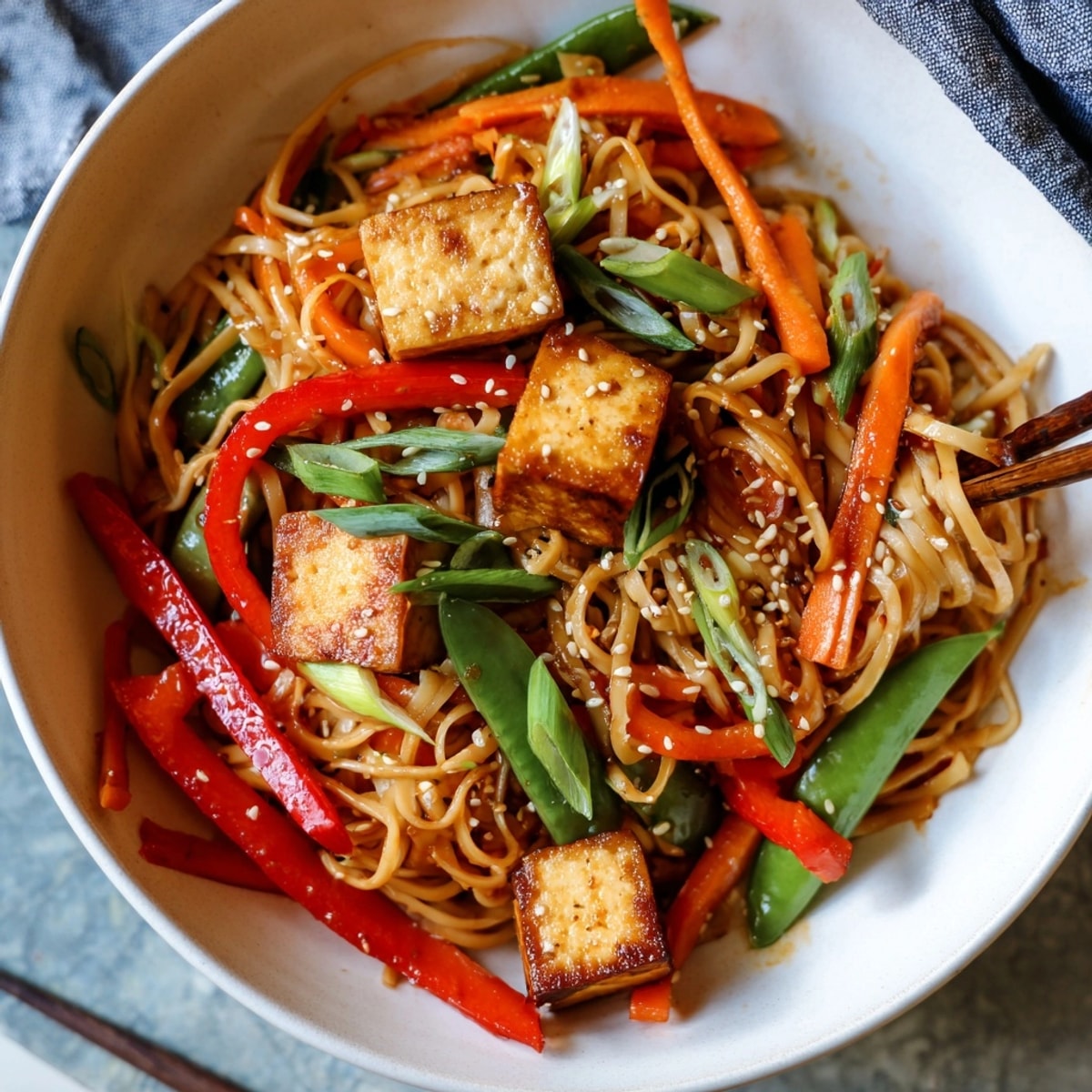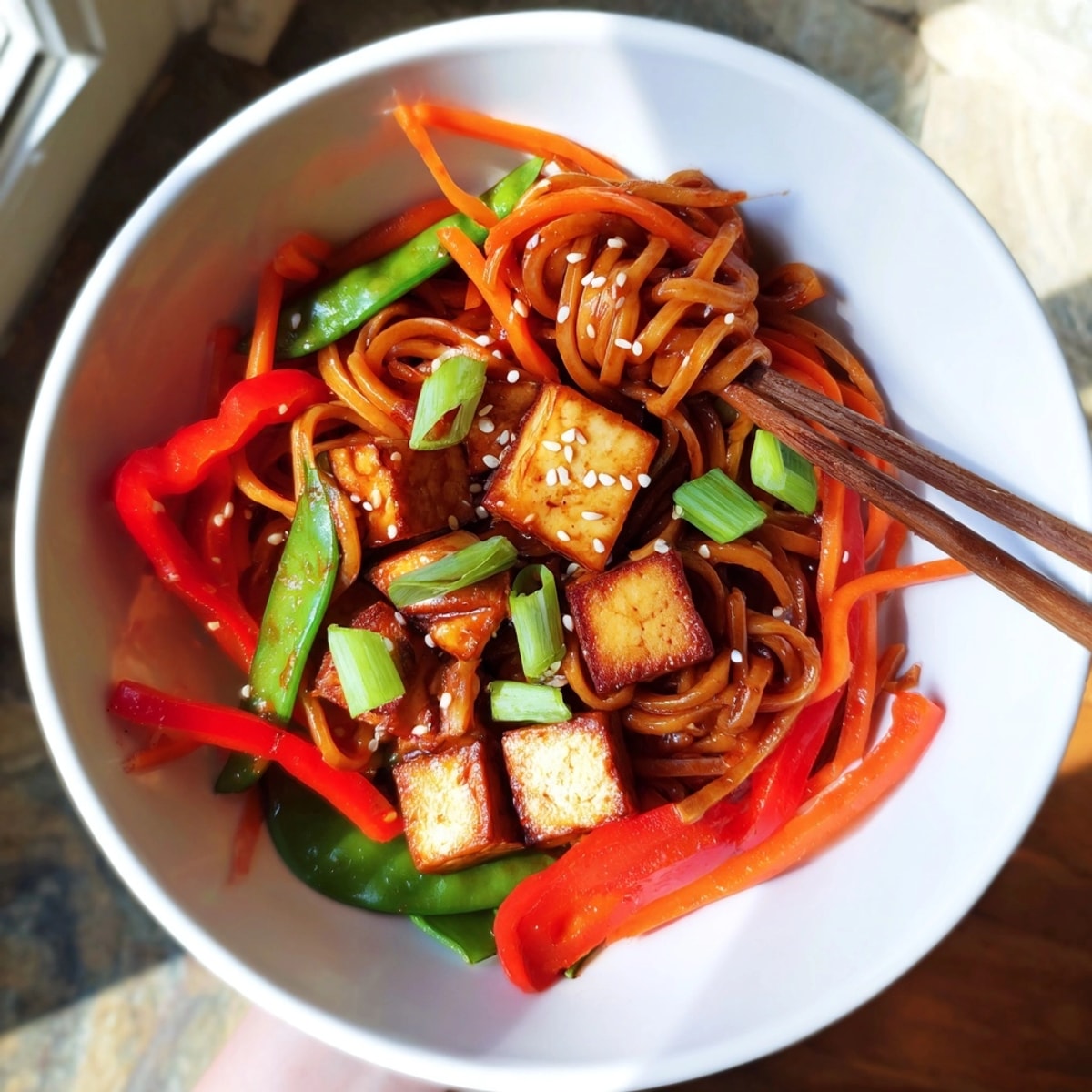
Crispy cubes of tofu meet chewy noodles in a savory blend of gochujang, soy sauce, and aromatics. Quick marination infuses flavor, while a lively stir-fry of carrots, bell peppers, and snap peas adds sweetness and crunch. The spicy, slightly sweet sauce brings everything together. Garnished with spring onions and sesame seeds, this Korean fusion main is satisfying and simple enough for busy nights, yet packed with bold flavor and color. Customizable for gluten-free diets, it pairs deliciously with a crisp Riesling to soothe the heat.
Vibrant and packed with punchy flavors these Gochujang Tofu Noodles are my go-to for a weeknight dinner that never fails to brighten the table and satisfy that craving for both heat and comfort. The crispy tofu mingled with sweet spicy sauce and fresh veggies makes every bite deeply addictive. I love how fast this dish comes together and that it is easy to tweak depending on what is in the fridge.
I first whipped this up after a long day craving something bold but simple. Now it is a regular request from my family because the sauce is so irresistible and the tofu stays wonderfully crispy.
Ingredients
- Firm tofu: about 400 grams Look for tofu that feels sturdy and springs back when pressed This keeps the cubes from breaking up during cooking
- Soy sauce: Choose naturally brewed for a richer flavor Provides depth to both tofu and sauce
- Sesame oil: Toasted version adds a comforting nuttiness always worth choosing for maximum aroma
- Cornstarch: Helps create the crispy golden crust on the tofu
- Dried wheat noodles: Can use soba or rice noodles if preferred Look for noodles with a firm texture to hold up well in the sauce
- Carrot: Fresh and colorful adds crunch Pick medium size with smooth skin
- Red bell pepper: Sweet and vibrant Choose one that feels heavy for its size
- Sugar snap peas: Bright and juicy slices add a refreshing snap Choose plump pods with glossy skin
- Spring onions: For tangy brightness and a little bite Look for fresh greens and firm bulbs
- Toasted sesame seeds: Boosts nutty complexity and finish Make sure they are fresh and aromatic
- Gochujang: Korean chili paste Essential for spicy savory flavor the heart of this dish Opt for one labeled mild or hot based on your heat preference
- Rice vinegar: Adds gentle tartness to balance the sauce Should be clear and mellow in aroma
- Honey or maple syrup: Brings the sweet note Use pure honey or a rich maple syrup for best results
- Garlic and ginger: Go for fresh cloves and knobs Firm and fragrant delivers real depth
Instructions
- Prep and Marinate the Tofu:
- Cut the firm tofu into even cubes about two centimeters Press gently between paper towels to remove excess water Place cubes in a mixing bowl Add soy sauce and sesame oil Toss to coat and let sit for five minutes Sprinkle the tofu with cornstarch and toss again until every piece is lightly coated
- Crisp the Tofu:
- Heat a nonstick skillet over medium high Add just enough oil to thinly cover the surface When hot add tofu cubes Arrange in a single layer Let them cook undisturbed for about three minutes Flip and repeat until all sides are golden and crisp This will take approximately eight minutes Remove tofu and set aside
- Boil the Noodles:
- Bring a saucepan of water to a boil Add dried noodles Stir to separate as they cook Follow package instructions for ideal texture usually between six and eight minutes Drain then rinse under cold water to halt cooking and prevent sticking Set aside
- Make the Gochujang Sauce:
- In a small bowl combine gochujang soy sauce rice vinegar honey or maple syrup toasted sesame oil minced garlic grated ginger and a splash of water Whisk vigorously until the mixture is silky Adjust the water until the consistency is pourable but not thin
- Stir Fry the Vegetables:
- Return the skillet to medium high heat Add a splash more oil if needed Add julienned carrot thin red bell pepper and halved snap peas Stir fry for two to three minutes until vegetables begin to soften but stay vivid Do not overcook to keep the crunch
- Combine Everything:
- Add cooked noodles and crispy tofu to the skillet with vegetables Pour the gochujang sauce over Toss thoroughly with tongs until everything is evenly coated and heated through about two minutes
- Serve and Garnish:
- Divide noodles among bowls Scatter sliced spring onions and toasted sesame seeds over the top Serve immediately so the tofu stays crisp

Makes four generous servings so ideal for meal prep and leftovers One of my favorite ingredients is gochujang It creates such a unique depth that lingers on the palate and actually feels invigorating My kitchen always has a tub ready for noodle night My best memory with this dish is making it for my partner on a chilly evening Stirring in the sauce and smelling the fragrant steam made us both laugh because we could not wait for dinner
Storage Tips
Store leftovers in airtight containers in the fridge for up to three days To reheat add a splash of water or broth and warm gently in a skillet the tofu will lose a little crisp but the flavors stay punchy Avoid microwaving the entire batch at once for best texture
Ingredient Substitutions
For gluten free use tamari and swap out wheat noodles for rice noodles The tofu could be replaced with tempeh or even crispy chickpeas in a pinch If fresh vegetables are not on hand frozen stir fry mix works just fine
Serving Suggestions
Serve bowls with extra sliced chilies if you love more heat A side of kimchi or pickled radishes rounds out the meal beautifully Pairing with a chilled riesling or ginger beer makes every spicy bite sing
Cultural and Historical Context
Gochujang is a staple in Korean kitchens dating back centuries It is known for bringing complex heat and sweetness to countless dishes This noodle twist blends the iconic flavors of Korean spice culture with easy fusion techniques making it accessible everywhere
Seasonal Adaptations
Swap snap peas for broccoli florets or baby spinach in cooler months Add summer zucchini or shredded cabbage when in season Use roasted sweet potato to bring mellow warmth to winter bowls

Prep all veggies and sauce before heating your pans for smooth flow Taste your sauce before tossing with noodles Adjust heat and sweetness as needed
Recipe FAQs
- → Can I use rice noodles instead of wheat noodles?
-
Yes, rice noodles are a great gluten-free alternative and work deliciously with the spicy sauce and vegetables.
- → How do I get tofu crispy?
-
Press the tofu to remove excess moisture, coat with cornstarch, and cook in a hot skillet with a little oil until golden on all sides.
- → Is there a vegan option for the sauce?
-
Absolutely! Swap honey for maple syrup or agave in the gochujang sauce for a fully plant-based meal.
- → What vegetables can I add for variety?
-
Spinach, bok choy, mushrooms, or shredded cabbage are tasty additions that boost nutrition and texture.
- → How spicy is this noodle dish?
-
The heat level is moderate from gochujang. Increase or reduce spicy ingredients to suit your taste.
- → What is the best wine pairing?
-
A crisp, slightly sweet Riesling balances the dish's heat and matches its vibrant flavors beautifully.
